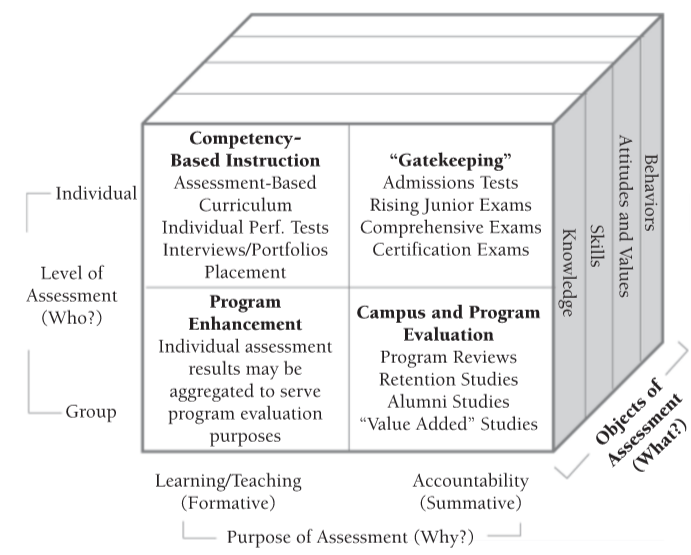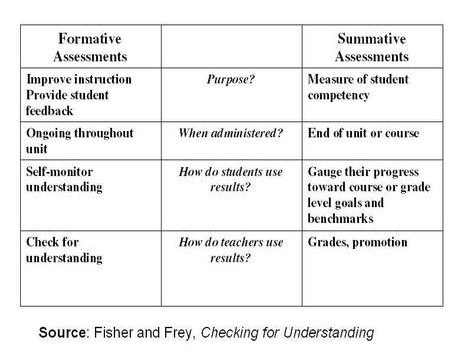Assessment
What are you measuring and why?
What is Assessment?
Assessment is the measurement of student understanding. Sounds deceptively simple, doesn’t it? All we are doing is measuring. What are we measuring? Understanding. This is where things get complicated. In fact, assessment is one of the most complex aspects of the whole teaching and learning endeavor because measuring understanding is so challenging. The average person has around 100 billion unique neurons and those neurons make about 100 trillion unique connections. Every student brings a unique background to a given learning experience and even though a lecture hall may contain 600 students, every student is experiencing that lecture individually and making unique connections within the new information and to their previous understandings. With this small hint of the complexity of the situation, we start to shed some light on why creating accurate systems for quantifying understanding for groups of students is among the most challenging tasks an educator can pursue.
Assessing each and every student individually, perhaps through lengthy individual conversations or practical examinations would be ideal, but that process would require too much of our time. Instead we come up with various instruments and methods, surrogates mostly, to estimate student understanding en masse. We know that some students demonstrate their understanding via one method better than another, so we often include several different opportunities for students to shine. We might offer multiple choice exams as well as some papers or even projects or presentations. Sometimes we assess students on class participation or discussion participation as a partial surrogate for understanding, and sometimes on grammar or punctuation and even on attendance or tardiness.


How Do I Use Assessment in My Course?
To get at the root of what makes for good assessment, we have to ask a couple of hard questions.
Why are we assessing? Are we assessing for our own purposes, for the purposes of the institution, or for the student?
Formative assessment offers opportunities for students to absorb, reflect, and revise. This form of student centered assessment is more like an ongoing conversation, where an instructor offers formative feedback and students have the chance to demonstrate their improved understanding.
Summative assessment is frequently used for single instance snapshot events that are often appropriate for certification exams and admissions tests. Institutional assessment, or gateway type assessments tend to be more summative in nature.
What we are assessing? If we are assessing foundation knowledge, a multiple choice exam or a term paper may be appropriate. If we’re assessing some of the more complex aspects of student understanding such as changing attitudes and values, something which many instructors profess to affect in their teaching, a multiple choice exam is likely insufficient. Reflective activities or class discussions may be a more effective venue for students to demonstrate these deeper understandings. Remember our discussions of learning taxonomies when thinking about assessment. Rich, formative assessments generally offer more opportunities for students to display and develop deeper, richer understandings than summative assessments.
How-to Instructions and DIY
Many find the exercise of mapping the structure of their course valuable. Using the backwards design model, begin with your big ideas, essential questions and enduring understandings and work your way toward assessments and activities. You’ll find that more than “backwards” or building in any one direction, this process involves a great deal of back and forth and fine tuning. You may find this example map helpful). It is modeled on Wiggins and McTighe’s Understanding by Design Tree.
Questions and Considerations
It is essential to ask yourself what you are assessing and why. In addition, there are several other important questions and considerations:
If you plan on using formative assessment, how are you going to offer students opportunities to revise their work? Are you going to scaffold students through a more formal process and ask for multiple drafts of a paper, project or presentation? Alternatively, does it make sense to simply offer students the opportunity to re-do any of their work. Is this realistic for your time schedule?
What is your philosophy toward grades? What is an “A” for you? Should every student be able to achieve an A? If one student performs exceptionally on their first try, and another student finally achieves that same level after multiple revisions, how will you grade their work? Keep in mind the previous questions of what are you assessing and why. Are you accurately able to determine the differences in student understanding between an 89% and a 91%? Many faculty use grading systems that make more sense to them than standard percentage or letter grade systems. What makes sense to you?
Consider other systems of motivational assessment such as a game based point system where student scores climb with each success rather than diminish with each opportunity for failure.
Technologies
The following list contains a limited set of examples of how some technologies may assist your assessment efforts:
- Use a shared Google Drive folder and Google Docs as part of a submission and revision workflow with your students.
- Use Canvas’s efficiency at delivering auto-graded quizzes to require students obtain content mastery (achieve 100% correct scores) before they move on to subsequent material featuring richer assessments such as presentations and discussions.
- Use synchronous tools such as Zoom to increase informal formative assessment opportunities.
Faculty Perspectives
Take a moment to watch and listen to Dr. Richard Buckland discuss his innovative thinking on the subject of assessment. This entertaining presentation provides many challenging perspectives on traditional models of assessment.
Further Resources
Research Foundations
Banta, T. and Palomba, C. (2014). Assessment Essentials: Planning, Implementing, and Improving Assessment in Higher Education, 2nd Edition. San Francisco: Jossey-Bass.
Huba, M. and Freed, J. (2000). Learner-Centered Assessment on College Campuses: Shifting the Focus from Teaching to Learning. Pearson Higher Ed.
Meyer, C. (1992). What’s the difference between authentic and performance assessment? Educational Leadership, 49 (8). 39-40.
Terenzini, P. (1989). Assessment with Open Eyes: Pitfalls in Studying Student Outcomes. The Journal of Higher Education, 60(6), 644-664.
